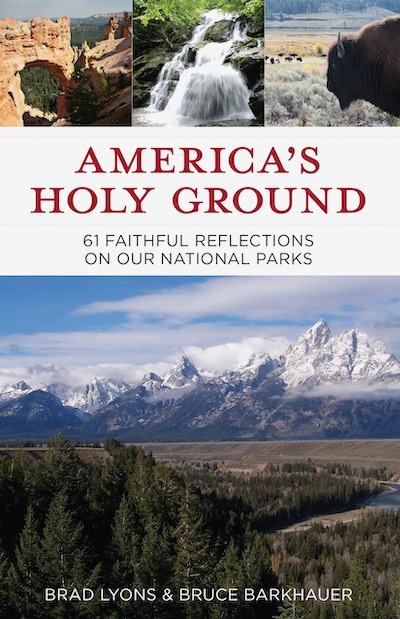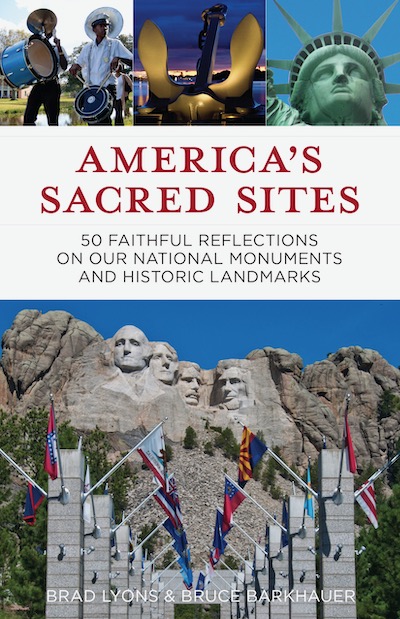
.
Discovering the Sacred in Our Heartland—
GREAT FOR INDIVIDUAL READING, FAMILIES AND SMALL GROUPS
.
By DAVID CRUMM
Editor of ReadTheSpirit Magazine
What’s the last thing most of our families are thinking about this fall?

Click the cover to visit the book’s Amazon page. The book also is available via Barnes & Noble and many other retailers.
Taking a road trip.
But, that’s exactly what two spiritual guides are inviting us to undertake in a pair of unique, beautifully illustrated volumes that—we promise you—will be a welcome addition to your reading list this autumn and winter. That’s true even if your spiritual “road trip,” for now, is only the start of a plan for yourself as an individual or with your family, friends or congregation.
Now is the time to open our horizons, once again, as we think about what defines—and unifies—this vast and diverse nation of ours.
Co-authors Brad Lyons and Bruce Barkhauer hasten to add that our National Parks (and monuments and historic landmarks and other park service sites) are open right now to visitors. Of course, some indoor or enclosed areas within these sites may be closed or access may be limited due to safety concerns during the pandemic. But, the sites themselves are open. You can leave your home whenever you feel so moved and wind up standing on these sacred grounds to renew your spirit.
“If you want to know about the current rules, all you’ve got to remember is the website NPS.gov and you’ve got access to the latest information about any of the locations,” said Lyons, who also is president and publisher of Chalice Press, which produced these books. “Wherever you live, there is a national park site not too far away.”
In fact, there are 421 sites in the National Park System with more added to the roster each year. The highest designation, “national park,” is held by 62 of the facilities, since the White Sands Monument became the official White Sands National Park on December 20, 2019. (NOTE: That was after press time for the first 61-site volume in this series, so Lyons and co-author Bruce Barkhauer are adding reflections on “Bonus Parks” to their website for the book series.)
Among the many new and upcoming sites within the system: The Dwight D. Eisenhower Memorial was recognized by the park service on September 18, 2020. The Civil War Mill Springs Battlefield was moved up to the status of a national monument on September 22, 2020. On the list of new sites in the planning process is the Medgar and Myrlie Evers Home National Monument, which is authorized by the park service but still is in the process of acquisition and development of the facility.
How many park designations are there? Across the entire system, there are 19 different naming designations.
.
Ready to Open Your Spiritual Horizons?
The two books are: America’s Holy Ground: 61 Faithful Reflections on Our National Parks—and America’s Sacred Sites: 50 Faithful Reflections on Our National Monuments and Historic Landmarks.

Click on the cover to visit the book’s Amazon page. The book also is available via Barnes & Noble and many other retailers.
Barkhauer and Lyons have been involved in the production of Christian books and resources for many years. Lyons supervises the entire Chalice Press publishing house, which is part of the Christian Church Disciples of Christ. A few years ago for Chalice, Barkhauer wrote: Community of Prayer—Stewardship Devotional.
So, after years of working on more traditional publishing projects, why did they launch such an unusual series?
“Because we realize that people have a desire to find something other than the typical religious books that were produced in the past,” Barkhauer said in our interview this week. “There is a hunger for something deeper among people who have experienced so much turbulence in these tumultuous times. People are finding that what they thought was anchoring them—now is shaking. People are asking: Where can I take my questions to look for deeper answers?
“When we started working on what is now the first volume, we thought of this as a closed set: There were 60 parks. We would cover all of them in one book. Then, as we were working on that book, there were 61. And, now, there are 62, so we’re adding a reflection on that 62nd site to our website.
“Then, when we decided to do a second volume, we realized we could respond to the geographic holes in our first book. The 62 national parks are not evenly distributed across every state. California and Utah have a lot. Not every state has one. But—when we knew we could plan the second volume, this gave us an opportunity to fill in some of the geographic gaps. There is a national park unit of some kind in every state. So, that’s why we did 50 in the second book—one per state.”
The Power of a Daily Spiritual Journey
Most of these entries are four pages long, each one illustrated with about four color photos—so they are ideal for daily reading. Millions of us try to follow some kind of spiritual practice, often including a daily, uplifting reading of some kind.
That is why we have launched our own 30 Days With series of inspirational books with the first two volumes drawing from the wisdom of Abraham Lincoln and King David. More volumes will appear in 2021. What we are aiming at is a timeless desire for readings that can enlarge our spiritual imagination. Since ancient times, men and women have found solace and hope in daily prayers and reflections. Pew Research says 55 percent of Americans continue to do so on a daily basis.
One way to enjoy these new books from Chalice is to think of them as “111 Days With Our National Parks,” spread across two volumes. That’s enough reading for more than three months. Lyons and Barkhauer understand how much we all can benefit from recalling on a daily basis what spiritually unites us in these turbulent times.
That’s why they close each entry with a few questions for reflection. Just one example: At the end of a chapter that involves Native American food traditions—they raise a common Native American concern for future generations. The questions at the end of that entry are:
“Can you think of small actions that have blossomed into something much larger? From whose seeds have you harvested fruit? What seeds are you planting for future generations?”
‘Something out of the Ordinary Happened There’
In the opening pages of their newest book, Lyons and Barkhauer remind readers that this intertwined process of remembrance and spiritual reflection stretches back to the roots of our Abrahamic faiths. They write:
“Consider the stories in the biblical witness where a place is marked as special or sacred. In Genesis 12, when Abram enters Canaan—God having told him in a dream that he and his descendants will one day inhabit this land—Abram sets up a pile of stones, an altar, at the oak of Moreh. The place is to be remembered because something out of the ordinary happened there. In this case, it was the first concrete step of Abram living into the vision of what would become the biblical nation of Israel. Marking the place allows the history to live on beyond the individual or generation that experienced the event. …
“What is most remarkable to us today is that there is a place in every state of our union that has some significance in shaping us and our history. Consequently, there is a place near you right now where a visit can get you started on discovering more of America’s holy ground. We wish you blessings and safe as well as amazing journeys as we remember that our memories of the past, well tended, not only define who we are now, but can shape us into something even greater in our shared future.”
And, the best part of these co-authors’ collaborative style? They keep guiding us; they show us one remarkable site after another; they evoke the spirit of each place; they raise probing questions—but they don’t force answers on us. Each reader can draw unique insights.
“Every one of these reflections is open to your own interpretation,” Lyons said. “And, that’s appropriate to this kind of journey—and to these places. If any two of us visit Yosemite—even if we are good friends and visit together—we will have two different experiences. That’s why we never say in these books: This is the experience you’re going to have. We don’t want to limit anyone. We are offering invitations. We are asking questions. Your own experience, then, will take over. And, that’s as it should be.”
